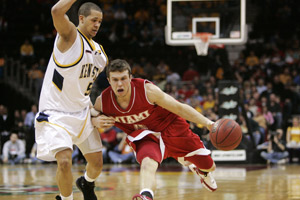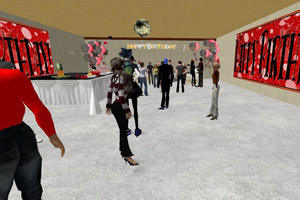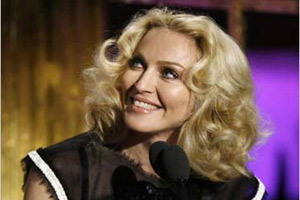Focus on America
Basketball's March Madness Thrills Fans, Boosts School Morale

It descends on America every year in late March, together with spring showers and the first blossoms on trees. It is a collective giddiness, excitement, even frenzy that involves gathering in groups, missing classes, making wagers and telling tall tales about the amazing Final Four and the “cutting of the net.”
It is March Madness, or the Big Dance, more soberly known as the National Collegiate Athletic Association (NCAA) Men’s Division I Basketball Championship, the annual tournament of the 65 best college basketball teams.
The road to the semifinals -- the Final Four -- takes three weeks. NCAA basketball tournaments can be unpredictable, and they are marked by high drama, with top college teams trying to maintain their winning legacy and underdog teams desperately vying for an upset.
U.S. college basketball can elicit as much (some say more) emotion as the best games of professional National Basketball Association (NBA) teams, and not only among students. Many consider it the best, purest form of the game before huge NBA salaries transform NCAA prodigies into highly paid performers, crowd-pleasers and media stars.
Despite highly complicated tournament rules, the late March-early April games are watched keenly and expertly analyzed by accidental fans, professional sports commentators and big league recruiters. They are considered the best indicator of the future of American basketball -- one of the three (with American football and baseball) mythical national games.
The tournament is split into four regions, with the organizers trying to make sure each region is fairly evenly matched in strength of teams compared with other regions. Each team plays on neutral ground: the rules prohibit them from playing on their home courts.
The winners from each region move to the Final Four -- to be played this year on April 4 and April 6 in San Antonio -- and the two winning semifinalists then play for the championship on April 7 in San Antonio.
The winner receives a gold-plated National Championship trophy. The second place team is awarded a silver-plated National Runner-Up trophy, and both semifinalists that do not make the championship game receive bronze plated trophies for third place.
Two other coveted awards are the marble and crystal trophy for the top-ranked team, presented by the National Association of Basketball Coaches separately from the NCAA events, and the Most Outstanding Player in the tournament award from the Associated Press.
Due to an increased participation of international players on U.S. college teams -- there were 406 foreign-born players on Division I teams this season, a 51 percent increase from the number in 1998 -- March Madness is quickly spreading today across the globe. (See “International Players Set for U.S. Basketball’s March Madness.”)
NCAA basketball tournaments are rich in folklore and rituals. One of the more peculiar is cutting down a basket net at the end of the regional and national championship games. Each player on the winning team takes one strand as a souvenir and the head coach claims the rest of the net.
Winning the NCAA tournament can be as powerful a boost to a school’s prestige as having a Nobel winner on the faculty.
The very term “March Madness” has a bit of a history and even helped establish a legal precedent. It was first used in 1939 by H.V. Porter, an official with the Illinois High School Association (IHSA) in an article about the state’s high school tournament. In the early 1980s, the term began to be connected with the NCAA tournament.
In the 1990s, both IHSA and the NCAA tried to trademark the phrase to use it in franchising. In an historic 1996 ruling, a United States court of appeals first introduced the concept of a “dual-use” trademark, granting the ownership of the term to both institutions to use for their own purposes.
Although not yet as popular as the men’s contest, the NCAA Women’s Division I Basketball Tournament is receiving increasing publicity and is considered part of March Madness. It was inaugurated in 1982; its popularity has increased since the final championship game was moved in 2003 to the Tuesday following the Monday men’s championship game.
The NCAA basketball tournament is the biggest and most profitable event in collegiate sports. But the NCAA does not keep the profit. Instead, the income from multibillion-dollar television contracts is distributed among basketball-playing schools to support intercollegiate competition.
Recently on Focus on America
Businesses Find New Ways To Make Money Online
 A university professor wants to use the principles and technology of online games in business.
A university professor wants to use the principles and technology of online games in business.
The technology in complex, multiplayer games like World of Warcraft, Second Life, EverQuest or EVE Online -- which organize thousands, sometimes millions, of players online to compete for points or populate “virtual” worlds -- offers new ways to get work done, Stanford University professor Byron Reeves says.
Playing Into the Future
 Participating in sports and physical activity has been an important part of the American lifestyle for more than a century. During that period, sports equipment and the games themselves have evolved and improved immeasurably. But Americans aren't resting on their laurels. They continue to find ways to make equipment and games better, safer, more environmentally friendly, and more engaging to their devotees.
Participating in sports and physical activity has been an important part of the American lifestyle for more than a century. During that period, sports equipment and the games themselves have evolved and improved immeasurably. But Americans aren't resting on their laurels. They continue to find ways to make equipment and games better, safer, more environmentally friendly, and more engaging to their devotees.
"Trailblazers" Honored by Rock and Roll Hall of Fame
 The artists honored by the Rock and Roll Hall of Fame in 2008 represent many of the styles and genres that have shaped the vibrant American musical landscape.
The artists honored by the Rock and Roll Hall of Fame in 2008 represent many of the styles and genres that have shaped the vibrant American musical landscape.